Coffee with Hazelnut Parkin
Italian meets Middle East on a trip to Yorkshire

I got pretty excited this Christmas ... a new drum machine, some comfy socks. Don't tell me you don't love a good sock, we all do.
One of the non-sock related items I received this year was a Silikomart Jr. Pillow. Now that January's finally up (phew) I've had a chance to road test it.
This recipe will seem like a bit of an odd ball, but stick with me - the flavours work really well together.
Putting ginger in coffee is common in Yemen and other parts of the Middle East, but was also done in 17th century England. Since I have a tiny amount of Yorkshire blood in my veins, I thought mixing up some Espresso mousse with Parkin would make a great combo. It's also served with those other classic babylonian coffee pairings - rose and cardamom.
As noted, this recipe is based on a Jr. Pillow mould - but any cake or loaf tin about 20 cm long, 7cm wide and at least 5cm deep would work too.
Ingredients (Makes 1 individual cake, serving 6 people with lots of meringues and some parkin for the chef)
For the Hazelnut Parkin
- 50g blanched hazelnuts
- 100g unsalted butter
- 125g self-raising flower
- 20g caster sugar
- 20g muscovado sugar
- 40g treacle
- 100g golden syrup
- 1 tsp ground ginger
- 35g whole egg (approximately half a large egg)
- 5g whole milk
- Pinch of salt
For the white chocolate espresso bavaroise
- 60g freshly brewed espresso
- 65g full fat milk
- 125g white chocolate couverture
- 30g egg yolks
- 15g caster sugar
- 190g whipping cream
- 3g gelatine (about 1 1/2 sheets)
For the coffee Crème au Beurre
- 50g caster sugar
- 15g water
- 30g egg yolks
- 30g egg yolks
- 110g unsalted butter
- 10g espresso powder or instant coffee
For the white chocolate flocking
- 200g white chocolate couverture
- 140g cocoa butter
- 4 teaspoons of superwhite food whitener (optional)
For the cardamom and rose meringues (optional)
- 4 large egg whites
- 130g caster sugar
- 130g icing sugar
- 5 cardamom pods
- 1tsp rose flavouring
- Dried rose petals
- Red and green food colouring
Equipment required
- Jr. Pillow mould or similar
- Thermometer
- Piping bags and nozzles for plating
- Silicone mat
- Stand mixer
- Sieve
- Stick blender
- Spray gun
Make the parkin
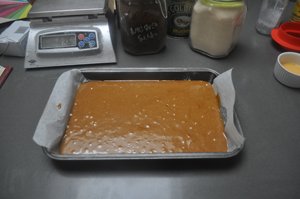
This is the best bit, as your kitchen will smell unreal.
Roast the hazelnuts at 200C for around 10 minutes, then crush roughly with your rolling pin or whizz quickly in a food processor.
Pre-heat the oven to 140C, then line a small brownie tin with greaseproof paper and some baking spray (or butter if you don't have any).
Place the butter, treacle, sugars, golden syrup and salt in a pot and, over a medium heat, stir until it's a thick liquid. Remove from the heat and leave to cool slightly.
Sieve the flour into a bowl, then add the ginger and roasted hazelnuts. Pour the sugar liquid over and beat with a spatula until it's all combined. Finally, beat in the egg and milk, then pour the lot into the tray.
Bake for 50 minutes, then remove from the oven and leave to cool completely.
Make the coffee Crème au Beurre
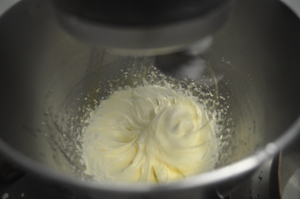
Place the egg yolks in the bowl of your stand mixer and whisk until pale. While this is happening, put the caster sugar and water in a pot, and heat to 121C
As soon as you're up to temp, carefully pour the syrup over the yolks and leave to whisk until it gains volume and is reasonably cool
Start adding the butter, piece by piece, with the whisk still running.
When all the butter has combined, take your espresso powder or instant coffee and blend it with a small amount of water to form a paste. Pour this into the mixture, and continue to whip until everything is combined.
Take your butter out of the mixer, and place into a tray of some sort - I used another brownie tin. Using a spatula or palette knife, form the butter into a block the same size as your mould. It should be around 1cm tall. Place in the fridge to firm up while you continue.
Make the espresso bavaroise
Soak the gelatine in cold water and set aside. Weigh your milk and espresso out into a heavy bottomed pan.Weigh out the white chocolate into another bowl with a fine sieve on top, and again set aside.
In a 3rd bowl, place the egg yolks and whisk them with the caster sugar until they become pale. Finally, get your thermometer ready.
Put the espresso milk over a medium heat until boiling. Carefully temper the egg yolks by pouring a little milk over them while whisking. Continue to add more until all the milk has been combined with the yolks.
Pour this back into the pan and keep stirring with a wooden spoon. Read the temperature - raise it until the thermometer reads 82 degrees C then immediately squeeze the liquid off the gelatine and whisk in. Pour the mixture through a sieve onto the chocolate. Let this sit for a few minutes, then use a stick blender to blend everything to ensure it's totally smooth.
When you're happy it's all blended, set aside in the freezer for 10 minutes to firm up.
Remove from the freezer, and whip the cream until quite thick - enough to hold its shape for a few seconds if you drop some from a spoon. Fold the cream into the custard.
If you're using the Jr. Pillow, pour the bavaroise up to the half way point of the mould. If you're using anything else, fill your loaf tin or other mould up to around 1.5 cm. Place in the freezer for at least an hour and reserve the rest of the bavaroise at room temperature. You might need to beat it now and again to stop it from setting during the hour.
Forming the rest of the cake

Remove the mould from the freezer. Again if you're using the Jr. Pillow it has a cutter in the top of it which allows you to chop out layers that fit inside it (yes, it's massively cool). Take this cutter and chop out identical pieces of parkin and the Crème au Beurre.
If you're not using the mould, measure and cut pieces of both layers which are around 1cm less wide than your original bavaroise layer.
Either way, place the Crème au Beurre on the parkin and line them up, then put them in the centre of the frozen bavaroise. Pour over the remaining bavaroise, making sure it drips down the sides and into any un-filled spaces. Put this back in the freezer for another hour or two to set.
Make the meringues (optional)
This bit's optional, but the meringues are delicious so I'd recommend it if you have time
Pre-heat your oven to 110C.
Place the egg whites in the bowl of your stand mixer and whisk until soft peaks form. Shower in the caster sugar at this point, then keep whisking until the meringue is glossy.
Stop the mixer, then sieve in the icing sugar. On the lowest speed, whisk again for 15 seconds (so the sugar doesn't fly up in the air) then push the speed up to max for another 30 seconds until the sugar is fully combined
Split this mix between two bowls then add red colouring to one, green to the other. Pour your rose flavour into the red mix. For the cardamom, split the pods by bashing them in a pestle and mortar. Remove the shells, then bash again until a reasonably fine powder is formed. Place half the powder into the green bowl and mix thoroughly.
Put each mix in a piping bag with whatever nozzle you prefer, then pipe small meringues onto silicone trays. Cover the rose ones with dried rose petals if you have some, and dust the cardamom ones with the remaining cardamom powder.
Place in the oven for an hour, then remove and leave to cool
Spray
Put the chocolate, cocoa butter and superwhite (if using) in a heatproof bowl and place over a simmering pot of water.When everything looks completely melted, blend with your stick blender just in case then pour into your spray gun.
Take out a big box - a 12-hole wine box is a good size - and cut off top flap. Lay it down so you have flaps on the left, bottom and right. Place a chopping board in the box, then put a layer of greaseproof paper on top.
Remove the cake from the freezer, and release it from the mould.
If you're ready to spray, put your cake in the box and turn on the gun. When flocking, I normally rotate the cake 3 times to make sure it has built up enough.
Return to the freezer to harden.
Reserve any unused spray for another time (it keeps quite well for a month or so in an airtight box).
To serve
Remove the cake from the freezer around an hour before you want to eat. If you want to cut slices, I'd recommend not doing that any later than 30 mins after it has come out of the freezer or it will start to melt.
Serve slices with the meringues on the side (if using) and enjoy this act of randomness.

Arabic Coffee & Cardamom Brioche
Simple recipe for a great breakfast loaf
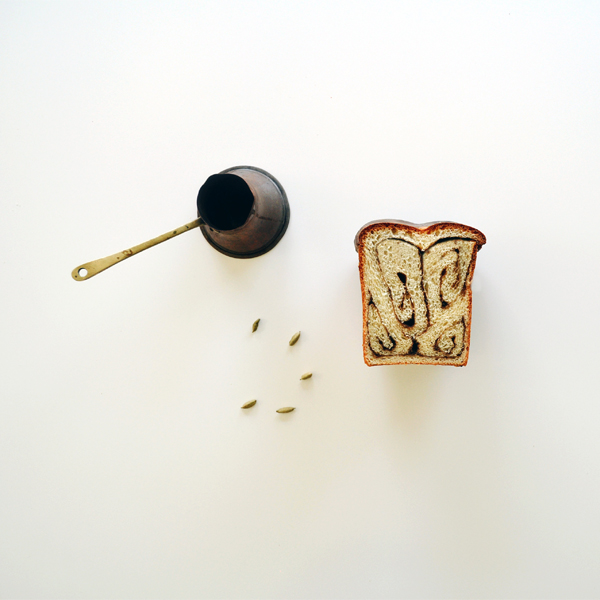
I'll always prefer espresso to any other type or method of coffee preparation, but Arabic coffee always brings back childhood memories of Sunday mornings.
All the Middle Eastern countries have their own claim to the way this type of coffee is prepared - in my house it was always the Armenian way; coffee, water, cardamom and sugar in the pot stirred then heated and risen twice.
This recipe combines the sweet coffee flavour with a rich brioche - best served lightly toasted to bring out the smell at breakfast time.
Makes 1 loaf
Ingredients
For the dough
- 400g strong white flour
- 7g dried yeast
- 10g salt
- 90g whole milk
- 100g unsalted butter
- 3 large eggs
- 30g caster sugar
For the filling
- 6 heaped teaspoons of finely ground Arabic-style coffee
- 30g caster sugar
- 10 cardamom pods
- 25g unsalted butter
For the glaze
- 1 large egg yolk
- 10g whole milk
Equipment
- Arabic coffee pot
- Muslin cloth
- Large loaf tin (3lb)
Start both the dough and filling the day before you want to make the bread.
Make the dough
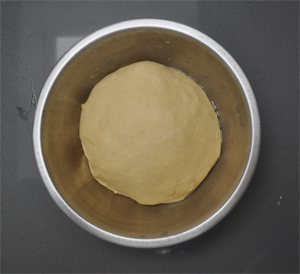 While I generally like to do things the traditional hand-made way, brioche is not the world's most fun thing to work with - so, place your dough hook on your stand mixer, and combine everything except the butter. Heat the butter very gently in a pot so that it melts almost completely, then let it cool slightly. Combine this with the rest of the ingredients, and turn your stand mixer to its lowest speed setting. Leave to knead for 10 minutes, then remove to a bowl, cover with cling film and put in your fridge for at least 7 or up to 24 hours.
While I generally like to do things the traditional hand-made way, brioche is not the world's most fun thing to work with - so, place your dough hook on your stand mixer, and combine everything except the butter. Heat the butter very gently in a pot so that it melts almost completely, then let it cool slightly. Combine this with the rest of the ingredients, and turn your stand mixer to its lowest speed setting. Leave to knead for 10 minutes, then remove to a bowl, cover with cling film and put in your fridge for at least 7 or up to 24 hours.
Make the filling

You'll need to prepare 3 servings of coffee. Gently crush your cardamom pods to release the seeds within, then discard the dry outer shell.
Place a bowl large enough to hold 3 coffees next to your stovetop. Place two heaped teaspoons of coffee into your pot, followed by 10g of sugar. Fill the pot approximately 1/3 up with water and place on a medium-high heat. Don't take your eye off it or you'll get a volcano of coffee all over your kitchen.
As the coffee rises up the pot, pour half into the bowl then return to the heat for a moment. This will then bubble up again; so then pour the rest into the bowl.
Repeat this process twice more with the rest of the coffee and sugar. When you're done, take a sieve and place it over a jug. Put your muslin cloth over that, and carefully pour the coffee through in order to take out the grounds. Don't squeeze too hard as Arabic coffee is very finely ground, and some might make it through.
Next, place the cardamom seeds into the filtered coffee and whisk in the butter while it's still reasonably hot. Leave it out to cool and infuse, then cover in cling film and place in the fridge.
The rise
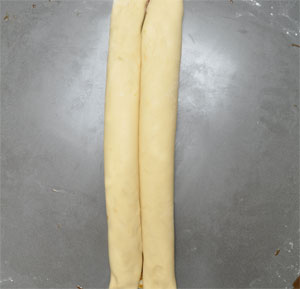 After your dough and filling are suitably cooled, take them out of the fridge and lightly dust a work surface with flour. Roll out the dough into a reasonably square shape approximately twice the length of your loaf tin, making sure you add a bit more flour underneath if it starts to stick.
After your dough and filling are suitably cooled, take them out of the fridge and lightly dust a work surface with flour. Roll out the dough into a reasonably square shape approximately twice the length of your loaf tin, making sure you add a bit more flour underneath if it starts to stick.
Spoon over the cooled filling, then use a flat spatula to try and spread it over the dough evenly. Next, start to roll one side in on itself, and keep rolling until you reach half way across your dough. Repeat with the other side so you end up with the two rolls meeting in the middle.
Butter your loaf tin, then gently cut the whole double-roll in half length ways so that you end up with two pairs of rolls. Place one set with the seam upwards in the bottom of the loaf tin, then invert the other so the smoother side is on top.
Leave this to rise for 3 or 4 hours, pre-heating your oven to 200 degrees C after about an hour.
After it has proved, make your egg wash by whisking the yolk and milk, then paint the top of your loaf and place it in the oven for 10 minutes. After 10 minutes are up, reduce the temperature to 180 degrees C and bake for a further 30 minutes. If your top looks too brown, cover in silver foil to stop it burning.
Once done, remove from the tin and let it cool for at least 15 minutes. Cut it, toast it, butter it and generally be happy.









